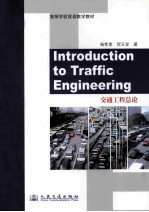

园林景观手绘表现技法 第2版PDF电子书下载
- 电子书积分:10 积分如何计算积分?
- 作 者:任全伟等编著
- 出 版 社:北京:科学出版社
- 出版年份:2013
- ISBN:9787030365897
- 页数:219 页
Chapter 1 I ntroduction 2
1.1 Definition,scope and goal 2
1.2 Traffic system 3
1.3 Background of development of traffic engineering 6
1.4 Responsibility and liability(professional ethics) 8
1.5 Transportation legislation 9
1.6 Characteristics of traffic engineering and challenges that traffic engineersface 10
1.7 Explanation of some technical terms 12
1.8 References 13
Chapter 2 Basic Concepts and Components in Traffic Engineering 16
2.1 Mobility versus accessibility 16
2.2 Classification of roadways 17
2.3 Uninterrupted and interrupted flows 19
2.4 Perception-Reaction Time(PRT) 20
2.5 Visual acuity——Static versus dynamic 21
2.6 Walking speed 23
2.7 Vehicle characteristics 25
2.8 Geometric characteristics of roadways 29
2.9 Traffic control devices 31
2.9.1 Traffic signs 32
2.9.2 Traffic markings 32
2.9.3 Traffic signals 32
Chapter 3 Volume,Density & Speed Studies 36
3.1 Definition of volumes 36
3.2 Definition of speed 44
3.3 Density 46
3.4 Relationship among volume,speed and density 47
3.5 Derivation of flow-speed and flow-density relationships 49
3.6 Finding capacity from basic speed-flow-density curves 50
Chapter 4 Spot Speed,Travel Time,and Delay Stud ies 54
4.1 Spot speed studies 54
4.2 Travel time studies 60
4.3 Delay studies 63
Chapter 5 Statistics and Application in Traffic Engineering 70
5.1 Some basic concepts 70
5.2 Distribution oftrafficflow 73
5.2.1 Poisson distribution 73
5.2.2 Binomial distribution 76
5.2.3 Exponential distribution 78
5.3 M/M/1 system——queuing theory application 81
5.4 Chi-square(x2)goodness-of-fit test 83
Chapter 6 Highway Capacity Analysis 92
6.1 Capacity,level of service and other related concepts 92
6.1.1 Definition of capacity 92
6.1.2 Concept of level of service and measure of effectiveness 93
6.1.3 Other related concepts 98
6.1.4 Factors affecting capacity & LOS(baseconditions) 100
6.1.5 Factors affecting the free-flow speed 101
6.1.6 Samples for free-flow speed estimation 103
6.2 Two types of analysis 104
6.2.1 Steps for operational analysis 104
6.2.2 Example for operational analysis 105
6.2.3 Steps for design analysis 107
6.2.4 Example for design analysis 108
6.3 Capacity analysis for two-lane highway 109
6.3.1 Classification of two-lane highway 109
6.3.2 Capacity of two-lane highway 110
6.3.3 LOS for two-lane highway 111
6.3.4 FFS for two-lane highway 112
6.3.5 Operation analysis for two-lane highway 113
6.4 Capacity & LOS analysis for weaving,merging,and diverging on freeways and multilane highways 117
6.4.1 Basic knowledge 117
6.4.2 Capacity of weaving area 120
6.4.3 Level of service criteria 121
6.4.4 Analysis of weaving areas 121
6.4.5 Analysis of merge and diverge areas 126
Chapter 7 Fundamentals of Intersection Design 154
7.1 Introduction to intersection control 154
7.1.1 Types of intersection 154
7.1.2 Hierarchy of at-grade intersection control 156
7.1.3 Capacity analysis of TWSC intersection 161
7.2 Basic principles and steps of intersection signalization 168
7.2.1 Terms and definitions 169
7.2.2 Saturation flow rate,lost times and capacity 169
7.2.3 The critical lane and time budget 170
7.2.4 Concept of left-turn and right-turn equivalence 172
7.2.5 Delay as a measure of effectiveness 173
7.3 Fundamentals of signal timing and design 174
7.3.1 Development of phase plan 174
7.3.2 Determination of vehicular signal parameters 177
7.3.3 Determination of pedestrian signal parameters 179
7.4 Computer software related to intersection signal timing 179
Chapter 8 Traffic Control Devices 182
8.1 Definition and categories of traffic control devices 182
8.2 Introduction of MUTCD 184
8.2.1 History and background of MUTCD 184
8.2.2 General principles of the MUTCD 185
8.2.3 Contents of the MUTCD 186
8.3 Traffic markings 187
8.3.1 Longitudinal markings 188
8.3.2 Transverse markings 189
8.3.3 Object markers and delineators 190
8.3.4 Word and symbol markings 191
8.4 Traffic signs 191
8.4.1 Regulatory signs 191
8.4.2 Warning signs 194
8.4.3 Guide signs 196
8.5 Traffic signals 198
8.5.1 Characteristics of traffic signals 199
8.5.2 Traffic signals warranty 203
8.5.3 Pedestrian signals 205
8.5.4 Other traffic signals 206
Glossary 209
References 219
- 《花时间 我的第一堂花艺课 插花基础技法篇》(日)花时间编辑部编;陈洁责编;冯莹莹译 2020
- 《数字影视特效制作技法解析》王文瑞著 2019
- 《景观艺术设计》林春水,马俊 2019
- 《最手绘 国风诗韵 写意水彩花卉技法》花酿 2019
- 《森眠子的手绘水彩教程》森眠子著 2019
- 《歌唱技法与风格研究》陈果著 2019
- 《大师手绘经典 世界的尽头》(西)西尔维娅·南克拉雷斯著 2019
- 《园林景观设计摭谈从概念到形式的艺术》李琰著 2019
- 《西方绘画技法经典教程 唯美的女人体素描》(日)山本雄三著;季成蹊译 2019
- 《马思聪交响音乐创作技法研究》高志方责任编辑;(中国)魏晓兰 2019
- 《市政工程基础》杨岚编著 2009
- 《家畜百宝 猪、牛、羊、鸡的综合利用》山西省商业厅组织技术处编著 1959
- 《《道德经》200句》崇贤书院编著 2018
- 《高级英语阅读与听说教程》刘秀梅编著 2019
- 《计算机网络与通信基础》谢雨飞,田启川编著 2019
- 《看图自学吉他弹唱教程》陈飞编著 2019
- 《法语词汇认知联想记忆法》刘莲编著 2020
- 《培智学校义务教育实验教科书教师教学用书 生活适应 二年级 上》人民教育出版社,课程教材研究所,特殊教育课程教材研究中心编著 2019
- 《国家社科基金项目申报规范 技巧与案例 第3版 2020》文传浩,夏宇编著 2019
- 《流体力学》张扬军,彭杰,诸葛伟林编著 2019
- 《指向核心素养 北京十一学校名师教学设计 英语 七年级 上 配人教版》周志英总主编 2019
- 《《走近科学》精选丛书 中国UFO悬案调查》郭之文 2019
- 《北京生态环境保护》《北京环境保护丛书》编委会编著 2018
- 《中医骨伤科学》赵文海,张俐,温建民著 2017
- 《美国小学分级阅读 二级D 地球科学&物质科学》本书编委会 2016
- 《指向核心素养 北京十一学校名师教学设计 英语 九年级 上 配人教版》周志英总主编 2019
- 《强磁场下的基础科学问题》中国科学院编 2020
- 《小牛顿科学故事馆 进化论的故事》小牛顿科学教育公司编辑团队 2018
- 《小牛顿科学故事馆 医学的故事》小牛顿科学教育公司编辑团队 2018
- 《高等院校旅游专业系列教材 旅游企业岗位培训系列教材 新编北京导游英语》杨昆,鄢莉,谭明华 2019
